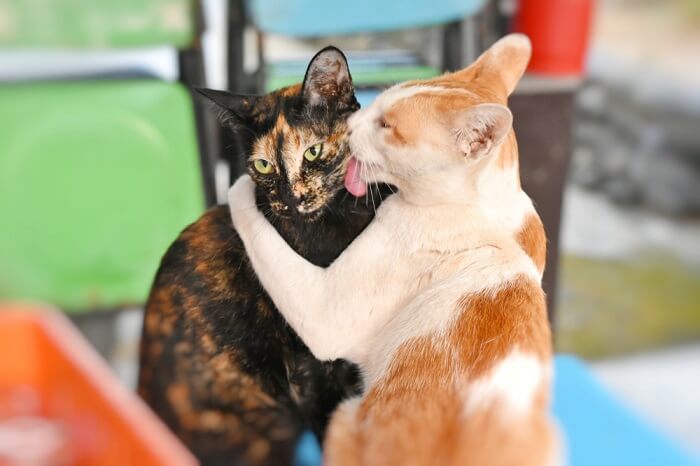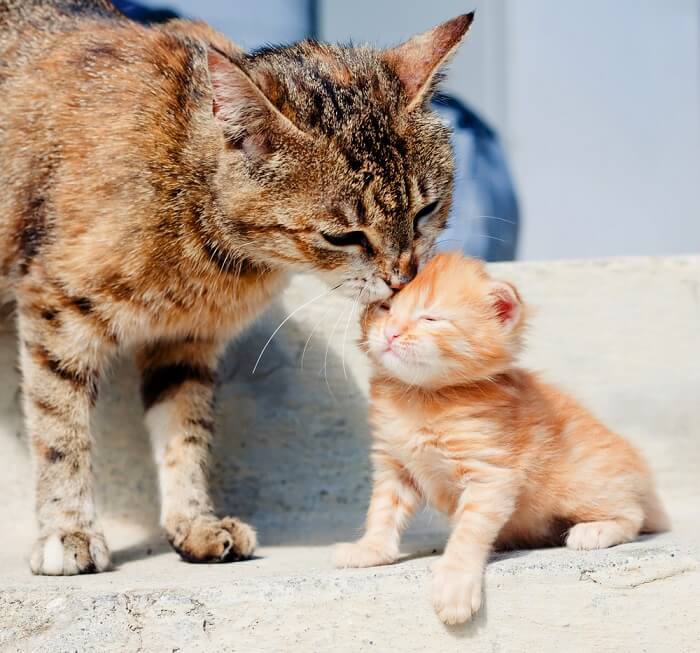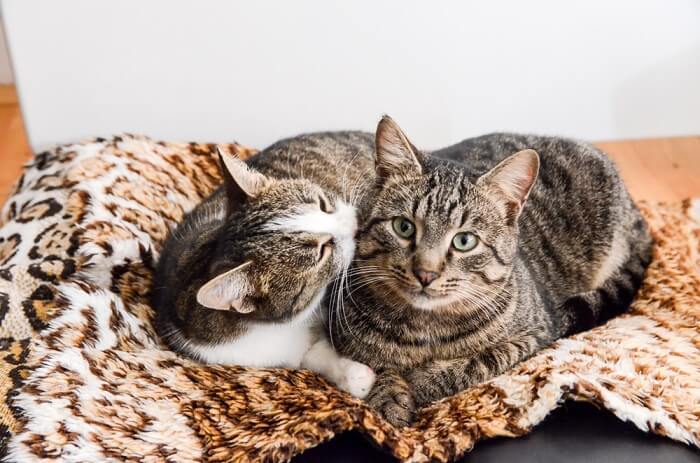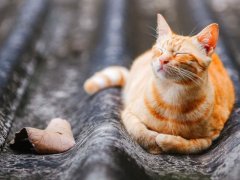
Domestic cats are fastidious animals, and the main way they keep themselves clean is through grooming. Many of us have multiple feline friends in the same household and have noticed that they groom not only themselves but sometimes each other.
How did this behavior evolve? How is it decided who grooms who? Let’s explore the details on why grooming plays an important role in the life and social structure of a cat.
Autogrooming vs. Allogrooming
Autogrooming is a word that means grooming one’s self.
Cat owner often ask “why do cats clean each other?”. The answer is that cats learn to autogroom as young kittens, and continue through adulthood. Most cats do this very well and keep themselves clean without much intervention from groomers or their owners.
As a pet ages, autogrooming may drop off due to other health conditions such as arthritis.
Allogrooming means grooming another.
Many cats participate in mutual grooming, when living in a multi-cat household or cat colony, including feral cat colonies. Allogrooming also starts at a young age, with the mother cat initiating the behavior. Social structure, dominance, and relationships also play a role in social grooming.
Why Do Cats Lick Each Other

Have you looked at a cat’s tongue closely?
Cats have very unique anatomy on their tongue with many tiny bristles lining the surface of the tongue. This is why it feels like sandpaper when a cat licks you! These bristles work as a tiny hairbrush.
By licking their fur, cats remove debris, excess hair, and parasites. If cats do not groom regularly, they can become matted or dirty, leading to health issues, difficulty hunting, or disruptions in a colony hierarchy.
Cats can lick too much, or over-groom. Barbering results in thin or patchy hair, broken hairs, or even scabs in some cases. Underlying health conditions can trigger over-grooming. Hyperthyroidism, arthritis pain, allergies, mites, and fleas all cause excessive grooming. If your cat has a change in their grooming behavior or is losing hair, schedule a visit with your veterinarian.
Grooming as a Kitten

When kittens are very young, their mother spends a lot of time grooming them.
Kittens are born blind and helpless, requiring constant care from the queen, their mother. By licking the kittens immediately after birth, mother cats remove tissue and fluids that could attract predators.
This post-birth grooming stimulates the kittens, dries their coats, and gets them moving and warmed. As the kittens grow, their mother licks them to stimulate urination and defecation. She also grooms them to keep them clean on a daily basis.
The feline family unit is built on shared space, shared scent, and shared behaviors, and littermates begin grooming each other at a young age.
If a kitten is abandoned and does not have the benefit of a mother cat’s nurturing, grooming behavior may suffer. Human foster parents mimic the queen’s grooming behaviors by using cotton balls, washcloths, or other materials to stimulate and clean the kittens as they mature.
Without littermates, orphan kittens may display inappropriate behaviors when introduced to other cats. Veterinarians and behavior coaches have resources to improve these special situations.
Dominance and Grooming
When two adult cats are together, who grooms who?
Studies in cat behavior show that most often a higher ranking cat grooms a less dominant cat. Most commonly, the dominant cat grooms their counterpart around the head, face, and neck.
These locations are vulnerable areas, and are also targets for aggression during conflict. Grooming “down” the ranks may be a method to show dominance without causing harm. In family units, all members are often needed for hunting, safety, and territory defense.
If a fight breaks out, an injury to one family member could compromise the safety of all. So, allogrooming may diffuse the situation and bypass aggression.
In a multi-cat household, dominance struggles appear frequently. Accessibility to resources usually trigger inter-cat aggression. Food, litter box, and territory are key resources in a feline environment.
Make sure that each cat has a safe and separate place to eat, use the litter box, and rest. Offering resources in different rooms, different levels of the house, and away from other pets like dogs, are strategies to alleviate stress and aggression.
In groups where cats are spayed and neutered, there is not an obvious relation between male or female preference in allogrooming. However, when intact female cats are together, evidence shows that females groom each other more often during breeding season.
Also, larger cats seem to exhibit dominance more frequently over smaller stature cats.
Signs of Bonding

When adult cats live together in a household, they often develop a strong bond. Grooming each other can be a sign of affection and bonding. Does your cat purr when their housemate is licking them?That is a good sign that it is a bonding behavior. If your pets appear relaxed while allogrooming, there is little reason to worry.
What about introducing a new cat?
A new cat can bring a new scent, foreign behaviors, and disrupt routine. Cat owners can help build bonds between a young cat and an older cat several ways. Neutralizing scent can help cats become more comfortable.
Use brushes and combs on both pets to help them become familiar with each other. Pheromones help ease tension, and there are synthetic pheromone sprays to reduce anxiety when introducing a new cat into a family.
Can Grooming Cause Problems?

The most common condition due to grooming is hairballs. As cats groom themselves and each other, their tongue picks up fur. They swallow the fur, which usually passes through their digestive tract without problem.
Some cats with long hair, or cats that groom excessively, can build up an accumulation of fur in their stomach. This rough material can trigger them to vomit up a hair ball, also known as a trichobezoar.
In rare cases, the hairball can become stuck in the stomach or intestine and require surgical removal.
If your cat has frequent vomiting or hairballs, certain foods and supplements may help them pass the hairballs more easily. Check with your veterinarian for advice on what might be best based on your cat’s needs.
As expected, grooming obviously involves saliva. Saliva can carry certain diseases, making grooming a potential way to spread certain diseases.
Feline Leukemia Virus is a disease that can be spread from cat to cat through shared environments and behaviors, including grooming. If your cat goes outside, be sure to test them for this incurable, viral disease, and vaccinate them as directed by your veterinarian.
Feline Immunodeficiency Virus is another disease that spreads through saliva, as well as blood. FIV most commonly spreads through cat bites and fights, and there is no vaccine available for this disease. While not directly spread through grooming, inter-cat aggression and dominance play a role in cat fights and FIV.
Grooming as Affection

Adult cats who share a home may groom each other as a sign of affection and bonding.
Cat grooming encompasses a variety of behaviors, and we still have more to learn. As cat owners, spending time brushing and petting our feline companions is a way for us to participate in this bonding ritual.
As long as your pet is relaxed during these interactions, grooming is a great way to spend time together. If your pet tried to leave, becomes agitated, or becomes aggressive, consider stopping for now and letting them have a break.
If you witness your cats grooming each other to the point where one is protesting or seems unhappy, offering a separate room or time apart can prevent fights. Grooming should be a relaxing and beneficial process.
Also Read: How To Take Care Of A Kitten: The Complete Guide
Frequently Asked Questions
How do I know if my cats like being groomed by each other?
Purring, relaxed posture like laying down or sleeping, and neither making an effort to run away show that things are going well.
What do I do if my cat has a bald area from the other cat licking them too much?
Excessive grooming or barbering can occur when a cat is exhibiting too much aggressive licking or dominance. In severe cases, secondary infections occur if the surface of the skin is ulcerated or broken.
Do other species groom each other?
Yes! Allogrooming has been observed in many other cat species such as lions, cheetahs, and other family group species. We don’t have as much information on the underlying factors that determine allogrooming in wild species.








I have an adult semi-feral cat. She came up a couple of years ago from nowhere. I have feed her and got her to let me pet her some- She is long haired and very matted. I have every kind of brush and comb you can think of to get them out. I know she is uncomfortable- is there a CBD pill or something I can calm her down so I can get those matts out? I feel so sorry for her. I need some advice.
For a semi-feral cat with severe matting, a calming supplement like CBD may help, but it’s best to consult a vet first to ensure safety and proper dosing. In some cases, sedation at a veterinary clinic may be the safest and most humane way to remove the mats—especially if they’re causing pain or limiting movement.
when my kittens got their surgery/microchipped, one of them didn’t feel very good for a few weeks after. her brother helped lick her ears/groom her bc he knew she wasn’t feeling good. it was so sweet 🥹
That does sound very sweet!
I have a 3 year old calico Minuet long hair cat who grooms her “sister”, a 12 year old Shih Tzu. Tina the cat doesn’t just lick Nina’s head, she mostly grooms her legs and side or what ever part she can get to while laying down. The two get along so beautifully that I have started writing a children’s book series, using real photos of their interesting life together.
Awesome! All of you sound very fortunate.
I have a mother cat which was a stray and her baby he is now 9 months old. She grooms more than necessary and still grooms the “baby” which is about her size at present. He grooms her too and it usually ends in fighting. Most of the time they are friends and often sleep together. The grooming fight is several times a day. I have not found a good way to feed them in separate areas, They run to see what the other is eating and both prefer to eat each others food. I have also tried putting them in separate rooms with the doors closed. They cry. I usually do not close doors, Is there a doable solution?
Are you sure that the fighting is problematic? Do either of the cats meow very loudly or seem to be hurt during the fights? It sounds like mom and son are very close, and perhaps this fighting is just a quick swat to say “I’m done now!”. If the fighting doesn’t seem to be detrimental to either cat, I wouldn’t really worry about keeping them apart. You can learn more in our article on deciding whether your cats are playing or fighting. The article also includes some tips to help stop the fighting. Hope this helps!
Gathered some very helpful information! Thank you
Fantastic! Happy to hear that!